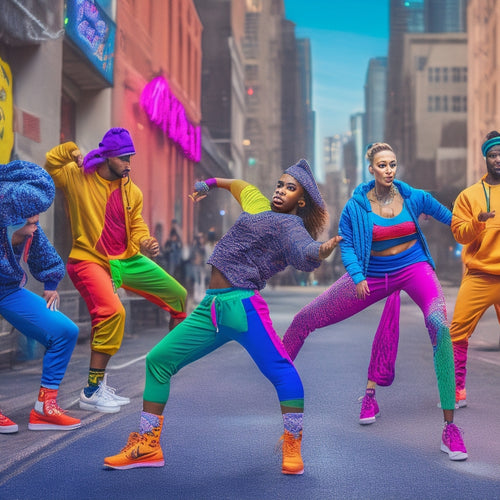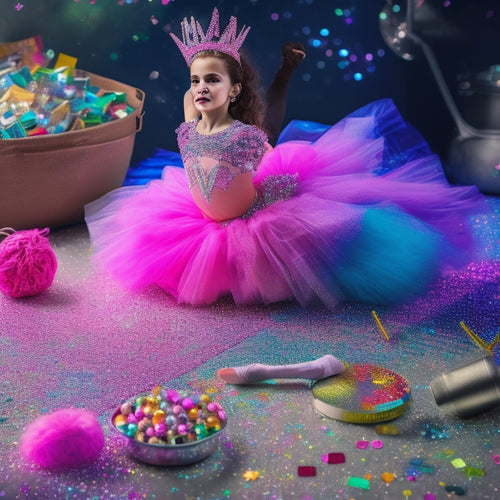
Dance Planner: Your Ultimate Teaching Resource
Share
As a dance instructor, a well-structured lesson plan is key to delivering engaging and effective dance classes that foster student growth and mastery of dance fundamentals. A dance planner serves as a valuable resource, providing a framework for mastering dance basics, organizing lessons, and elevating student engagement. By focusing on perfecting technique, developing a thorough curriculum, and incorporating interactive strategies, instructors can create an immersive learning environment that ignites students' passion for dance. Equip yourself with the tools to take your teaching to the next level, and reveal the full potential of your dance classes.
Key Takeaways
• Develop a comprehensive lesson plan with a clear curriculum to ensure cohesive and progressive learning experiences for your students.
• Organize your lessons with effective time management to allocate sufficient time for each activity and ensure a smooth flow.
• Track student progress to identify areas for improvement and provide targeted feedback for enhanced learning outcomes.
• Incorporate creative and interactive strategies, such as improvisation exercises or dance-themed games, to elevate student engagement and motivation.
• Focus on building a strong foundation in dance fundamentals, including proper alignment, breath control, and expression, to enhance overall technique and artistry.
Mastering Dance Fundamentals
Building a strong foundation in dance fundamentals is essential for dancers to execute movements with precision, control, and confidence, and for dance educators to effectively teach and choreograph.
To achieve mastery, dancers and instructors alike must focus on perfecting technique drills and practice routines. By rehearsing basic steps and combinations, dancers can develop muscle memory and improve overall technique.
Additionally, incorporating performance tips, such as proper alignment, breath control, and expression, can elevate performances and enhance overall artistry.
Organizing Your Dance Lessons
With a clear plan and structured approach, dance educators can transform their lessons into engaging, effective, and enjoyable experiences that promote student growth and success.
A well-organized lesson structure is essential to achieving this goal. By developing a thorough curriculum, dance educators can guarantee that their lessons are cohesive, progressive, and aligned with their teaching objectives.
Effective time management is also pivotal, as it enables dance educators to allocate sufficient time for each activity and make sure that their lessons run smoothly.
Additionally, tracking student progress is essential to identifying areas of improvement and providing targeted feedback. By implementing these strategies, dance educators can create a supportive and productive learning environment that fosters student success.
Elevating Student Engagement
To create a truly immersive and effective learning environment, dance educators must focus on elevating student engagement by incorporating creative and interactive strategies that capture students' attention and stimulate their passion for dance.
By incorporating creative activities, such as improvisation exercises or dance-themed games, educators can boost student motivation and encourage active participation.
Interactive learning experiences, such as peer-to-peer teaching or collaborative choreography projects, can also foster skill development and deepen students' understanding of dance concepts.
Frequently Asked Questions
How Do I Create a Dance Lesson Plan for Students With Special Needs?
Did you know that 1 in 5 people have a disability? When creating a dance lesson plan for students with special needs, incorporate Adaptation Strategies to foster an Inclusive Environment, ensuring safety and accessibility for all.
Can I Use Dance to Teach Other Subjects Like Math or Language?
"Absolutely! Dance can be a powerful tool for teaching other subjects like math and language through Cross Curricular Dance Integration, fostering a holistic and engaging learning experience that promotes creativity, critical thinking, and physical activity."
What Are Some Ways to Incorporate Cultural Diversity in Dance Lessons?
'A world of possibilities awaits! To incorporate cultural diversity in dance lessons, explore Cultural Fusion, where students learn traditional dances from diverse cultures, and Folklore Exploration, where they explore the rich stories behind each dance style.'
How Do I Deal With Discipline Issues in the Dance Classroom?
To address discipline issues in the dance classroom, establish clear expectations and consequences, promote student accountability through self-reflection, and implement proactive classroom management strategies to foster a safe and respectful learning environment.
What Are Some Tips for Teaching Dance to Students Who Are Shy or Hesitant?
When teaching dance to shy or hesitant students, foster a safe space with gentle encouragement, building confidence through gradual exposure to movements, and providing positive reinforcement to help them feel comfortable and empowered to express themselves.
Related Posts
-

Hip Hop Dance Apparel for Style and Function
Hip hop dance apparel combines style and functionality, so you can move with confidence and flair. Look for breathabl...
-

Exciting Lee Kiyoung Sticker: A Must-Have
Get ready to level up your self-expression game with Lee Kiyoung stickers! These customizable cuties offer unparallel...
-

Exclusive Crafting Files: Dance Mom Delight
Dance Mom Delight offers a wide collection of exclusive crafting files, providing users with a diverse range of digit...


